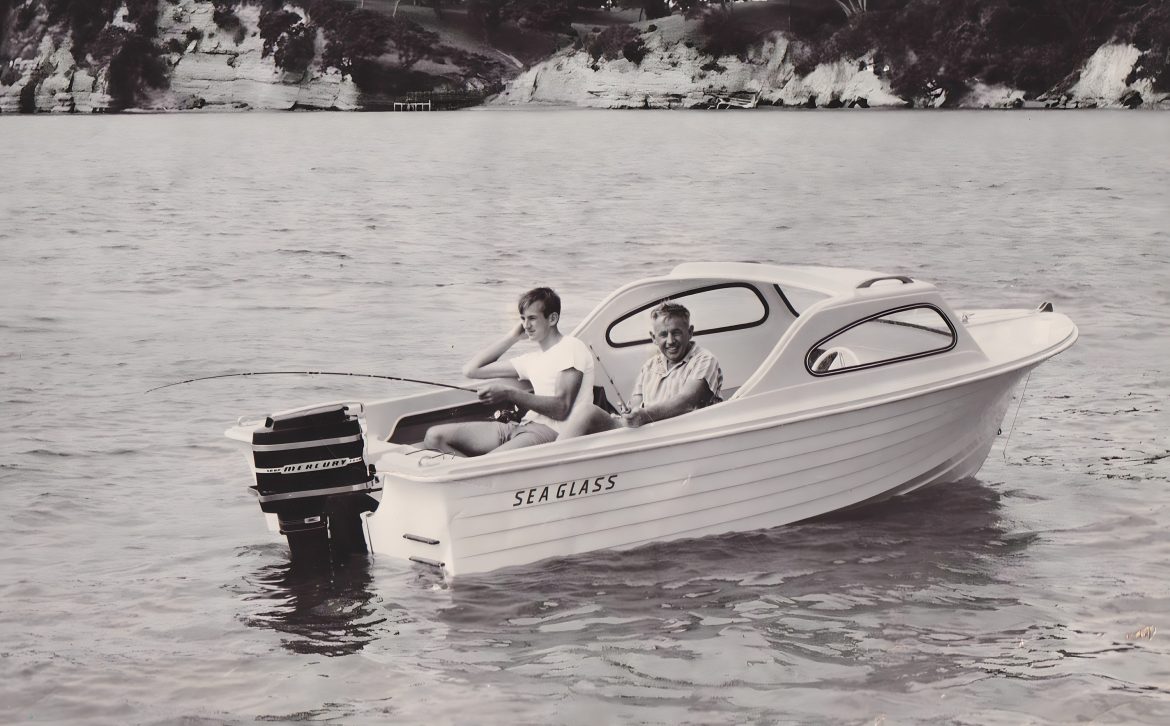THE HISTORY OF KIWI TRAILER BOATS BY THE DECADES
DIY RULED
After the Second World War, Kiwis once again looked at their leisure time, and as prosperity returned, the more adventurous thought about getting back on the water. While sailing boomed and with it, the launch and cruiser market, trailerable power boats were a little slower to take off.
Power options, unlike today, were limited for trailer boats. In the postwar years of the 1940s, the two giants of the outboard industry, OMC (Johnson & Evinrude) and Mercury, founded in 1939 by Carl Kiekhaefer, were both producing twin-cylinder 20 hp outboards. In 1948, Mercury released the Thunderbolt, a compact and sleek 4 cyl.-in-line 25hp outboard. OMC meanwhile topped out at a similar horsepower with its 2-cyl. Big Twin. However, because of import controls, these outboards were extremely rare. Only one 25hp Mercury Thunderbolt came to New Zealand, and it was fitted to a 4.3m runabout designed and built in 1948 by young Whangarei boatbuilder Richard Hartley (b. 1927), for Whangarei General Motors car dealer Jack Morgan, who christened her Miss Vauxhall. It was the age of outboard innovation, and the horsepower race had started between OMC and Kiekhaefer. This was a game-changer for the trailerboat market. While 25hp was fine for a small, lightweight runabout, it wasn’t ideal for a larger cabin boat. Most trailer boats in those days were built of timber and were heavy, which meant that the marinised automotive engine was the most common choice. That saw the rise of engine marinisation companies, with one of the best known being owned and run by Ron Augustin.
Ron was the son of Carl Augustin, who is regarded as the father of New Zealand trailer boating, with a history of building and designing boats that dated back to the early 1920s. In the late 1940s, he released the 6m Overlander, New Zealand’s first high-speed trailerable family cruiser. This plywood boat, shaft-driven by a marinised 4-cyl. Ford 10 car engine, had a top speed of 21 mph, which was outstanding for the time. The boat launched Carl Augustin’s career as a designer and builder of trailer boats. By the 1950s, Carl Augustin was busy selling boat plans and building boats, while son Ron was producing practically everything amateur home and professional boat builders needed to complete the drivetrain of an inboard powered boat, including struts, rudders, propellers and steering systems. The plywood and glues developed during the war that Carl Augustin used for his Overlander were transforming the construction process for small boats. It was also the beginning of do-it-yourself boat building. By the early 1950s, all around New Zealand, home builders were building boats, whether from scratch or from kitsets, with the smell of freshly cut timber and plywood, resorcinol glue permeating, and the tapping of copper nails reverberating, in back sheds everywhere. By the early 1950s, Kiwis could purchase bigger horsepower outboards, making them a better option for powering a trailer boat. Inboards were still popular, and we also saw the development of better boat trailers, plus the cars to tow them. Mark 10 Jaguars, Standard Vanguards and Humber Super Snipes from the UK and Dodge, Plymouth, Ford and Chevrolet from the USA were popular tow vehicles. Dedicated boat ramps started to appear around the country, with space to park a car with a boat trailer attached. Westhaven, built in the late 1930s when the breakwater was constructed along the Western end of St Mary’s Bay, had a wide multi-lane launching ramp in the 1950s on the Western side of the marina. The multi-lane ramp at the Eastern end has since replaced this.
By 1955, the outboard cruiser was becoming popular, and although very few, the interest was growing. Since WW2, two significant developments were mainly responsible for the growth in outboard-powered boats. The first was using resin-bonded plywood to turn out light, cheap, strong and easily mass-produced planing hulls and the second was the introduction of gear shifts to outboard motors in 1951. Things have come a long way since then, and little did we know the far-reaching implications the trailer boat market would have on the New Zealand boating industry. More importantly, the recreational outboard scene was about to boom at proportions never envisaged.
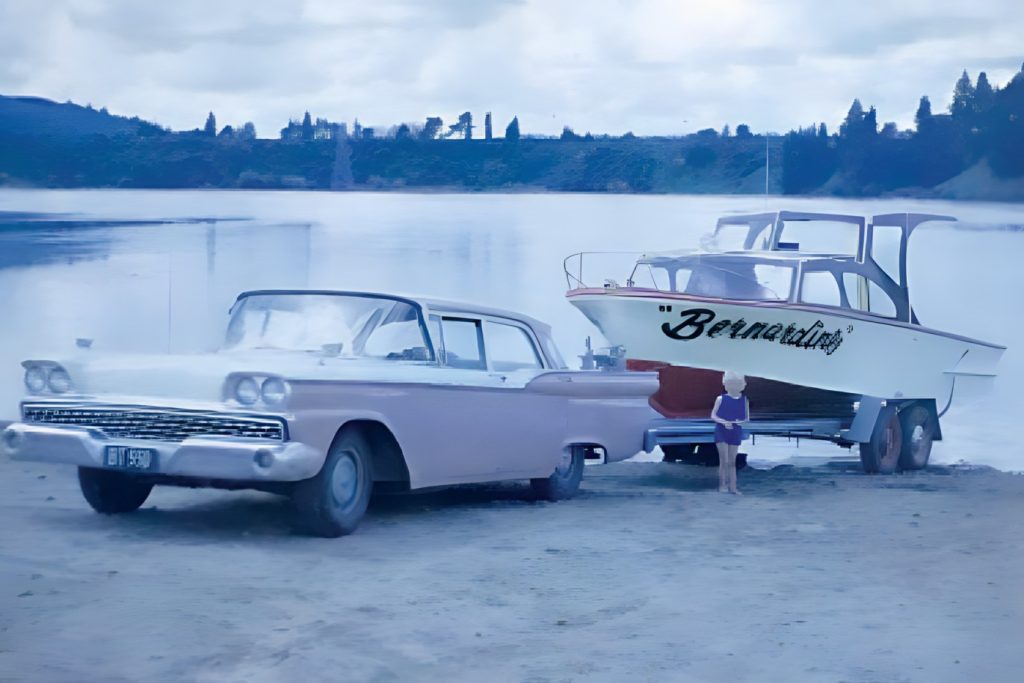
GRP IS BORN, BUT PLYWOOD RULES
Local builders didn’t immediately accept Fibreglass or GRP (glass reinforced plastic), but when it did around the 1960s, it changed the industry forever, Fibreglass was developed in the UK during the Second World War to replace the moulded plywood used in aircraft radomes (GRP being transparent to microwaves). There is a common misperception that fibreglass boats existed only from the 1950s, although it is true that serious production for the commercial market started about then. The fibreglass boat revolution began when polyester resin, invented in 1935, was used to build the first known fibreglass boat, a dinghy made in the USA in 1942. The resin required reinforcement, and builders experimented with various materials (even palm fronds) before settling on glass fibres. Other fibreglass boats followed, an example appearing at a US boat show in 1947. By the mid-1950s, the smells in local boat shops were changing. The tang of wood shavings was giving way to resins and glass fibres, and the writing was on the wall. Although many of the leading trailer boat builders loved building timber boats, they knew that fibreglass was becoming the boat building material of the future. Unless they changed, their company would be left behind.
In 1955, Arnold France produced New Zealand’s first production fibreglass moulded boats – a range of dinghies from 2.6 m to a 4.0 m runabout. Twenty were built in the first year. The 4.0 m runabout weighed 84 kg (185 lbs) and recorded 30mph with a 25hp outboard. Gisborne-based Condor Craft was also into small dinghy production and became one of the country’s major trailer boat builders. However, Fi-Glass turned the industry on its head and took volume boat production to a new level. Fi-Glass founder Frank Simpson, when interviewed by Barry Thompson in the 1970s, said he remembered those early days of fibreglass boat building. “Initially, I was against building fibreglass boats because Arnold France, who built under France Craft, appeared to have the market tied up. They were a bit rough, but solidly built, and I didn’t think there was an opening for another fibreglass boat builder in New Zealand.” However, only about three years after Arnold France started France Craft, Frank Simpson did get into building fibreglass boats in 1958, with the first model being a 12ft (3.7 m) Fisherman dinghy. It was a huge success, and over 65 years later, Fi-Glass boats can be found all over New Zealand and Australia. Fi-Glass is currently one of the largest manufacturers of fibreglass boats in New Zealand, with models from 4.75 m through to 6.4 m. Over six-and-a-half decades, Fi-Glass has built more than 10,000 fibreglass trailer boats – a number that no other Kiwi trailer boat manufacturer comes close to. In the mid-1950s, plywood was still the main construction medium for small trailer boats, and inboards were the most common power source. H.E. Cox designed a 4.3 m outboard plywood runabout that ran 14.5 mph with a Johnson 10hp but was looking for a significant increase in speed when the all-new 15hp model arrived. Jim Young, a name that would become iconic in the annals of Kiwi designers, was making a name for himself with small cabin cruisers. He pioneered the use of longitudinal girders instead of the then-conventional transverse frames. He would later become the designer/builder of the Vindex, one of New Zealand’s most popular and best-known cruising launches. Carl Augustin’s boat plans were selling well, with plans for models like the 6 m Overlander and 5 m Lazy Days available for £5. Popular power was a marinised Ford 10 running Ron Augustin components. Soon after World War 2, Sandy Sandsfounded Seacraft, building clinker timber dinghies, runabouts and 4.6 m cabin day boats, the latter available with inboard or outboard power. Many years later, the company switched to fibreglass construction, and today, under the name Haines Hunter New Zealand, it is one of the country’s leading GRP trailer boat builders.
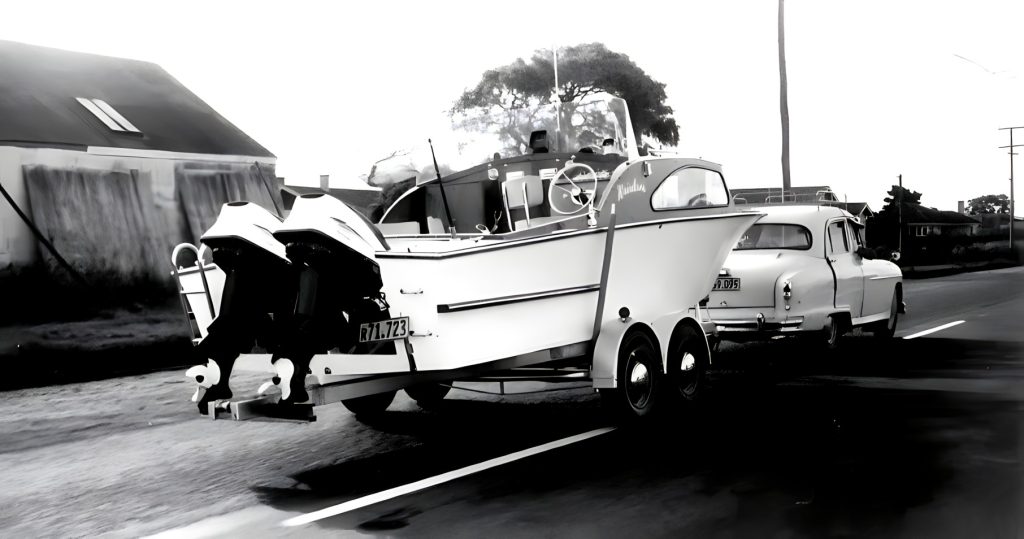
NZ SHOW BEGINS
The popularity of trailer boats soared through the mid to late 1950s and saw the first boat show, held as part of the 1956 Easter Show. The New Zealand Boat Show has been held, under various names, at the Auckland Showgrounds every year since and is New Zealand’s premium trailer boat show. Sea Craft exhibited at the first Auckland Boat Show with a range of clinker-built runabouts and dinghies. A 4.45 m Filco plywood runabout was one of the star attractions. Other brands included Aerolite, Lidgard, France, Tod, Hi-Fi (by Jim Young) and Augustin. Inboards were still popular, with brands such as Parsons, Graymarine, Stuart Turner, Ford 10, Watermota, Penta, and Norman. Chris Craft and Chrysler among the market leaders. In the mid 1950s, outboard brands such as British Seagull, Scott Atwater, West Bend, Konig, Johnson, Evinrude, Mercury and Clinton were available in New Zealand, but import controls and worldwide demand meant numbers were very limited to local customers. In August 1956, 19 interested people gathered for a meeting chaired by Seaspray editor John Mallitte, and it was agreed that a club known as the Outboard Boating Club of New Zealand be formed along the lines of the OBC in America. From those small beginnings with a handful of members, it has grown to be the country’s largest trailer boat club, with thousands of members and a dedicated base at Okahu Bay, Auckland.
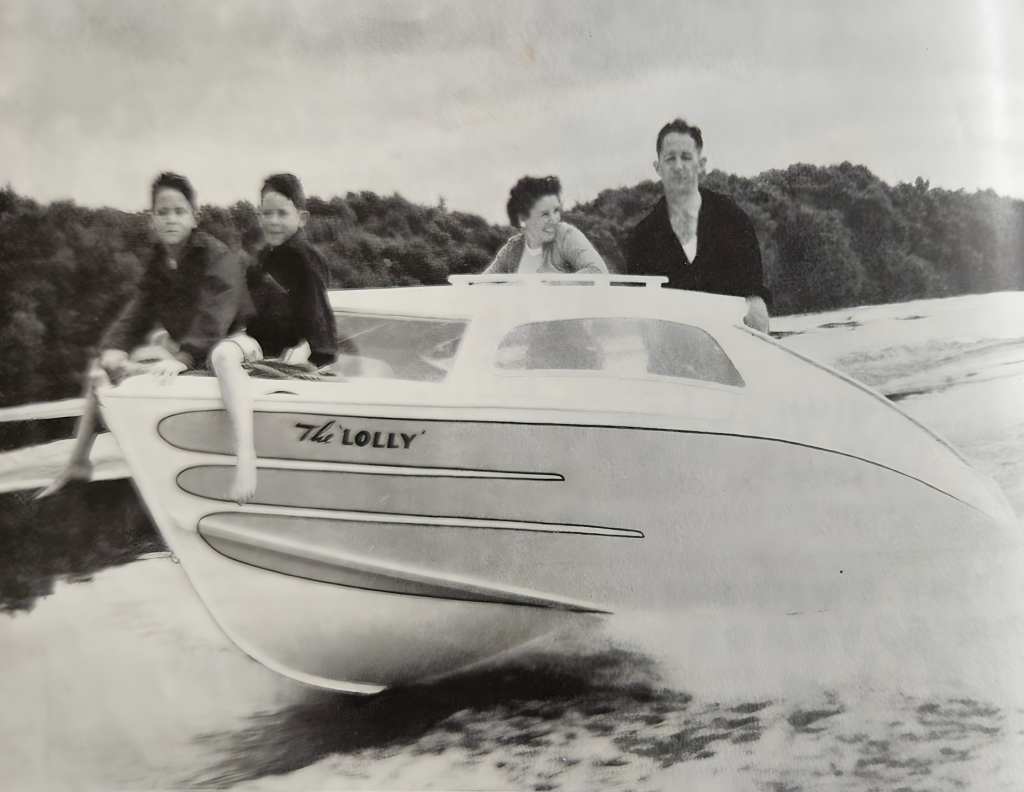
ALLOY ARRIVES…
ALMOST
Anyone interested in trailer boats in the mid to late 1950s would have heard of Marlin boats. Considered one of the prestige boats of the day, they were built by Sutton Mason & Co Ltd, owned by Cliff Sutton and Tony Mason. The Marlin 17 round bilge cabin cruiser released in 1956 became one of the most popular cabin boats of the time. In 1958, they increased their range to include 5.8 m and 6.7 m models, plus special tilting boom trailers. In late 1956, an amateur-built 5.7 m aluminium cruiser powered by a Johnson 25 debuted to a mixed response from traditional boat builders. This was arguably New Zealand’s first aluminium trailerable cabin boat. By the late 1950s, Wilfrid Hoelen’s name started appearing as a specialist builder of plywood boats. In 1959 Hoelen founded Sea Nymph, with the first model being a 12 ft (3.7 m) outboard runabout. Arnold France released a 5m cabin dayboat built in GRP, the biggest in the country and also introduced the 5.8m France Hi-Fi, complete with alloy hatch, built-in buoyancy, non-skid decks and the option of inboard or outboard power. The beam was just 2.1m, and the aft sections were almost flat.
American C. Raymond Hunt developed the deep-V in the late fifties and early sixties. However, Kiwi designers favoured relatively flat bottom boats, considering that a deep-V hull form would be unstable at rest because it would float with its chines clear of the water. Another major problem was that at the time, long-shaft outboards were for a transom height of only 20 inches, not the 25, 30 and 35 inches of today. By the late 1950s, C.W.F. Hamilton’s Hamilton jet boats were gaining popularity in the South Island, but in the North they were regarded as something of an oddity, being seen as riverboats and unsuitable for running offshore. How things have changed. Onboard electronics were still in their infancy, with radios and fishfinders a rarity. However, in 1957, Electronic Navigation Ltd introduced the Skipper 10 radio telephone for £51 and the top of the line Skipper 25 for £95. They were amongst the first compact marine radios and were popular in bigger trailer boats and launches. Paper charts were favoured, and thanks to the Hydrographic Service setting up chart sale agencies throughout the country, they were more readily available to recreational boaties.
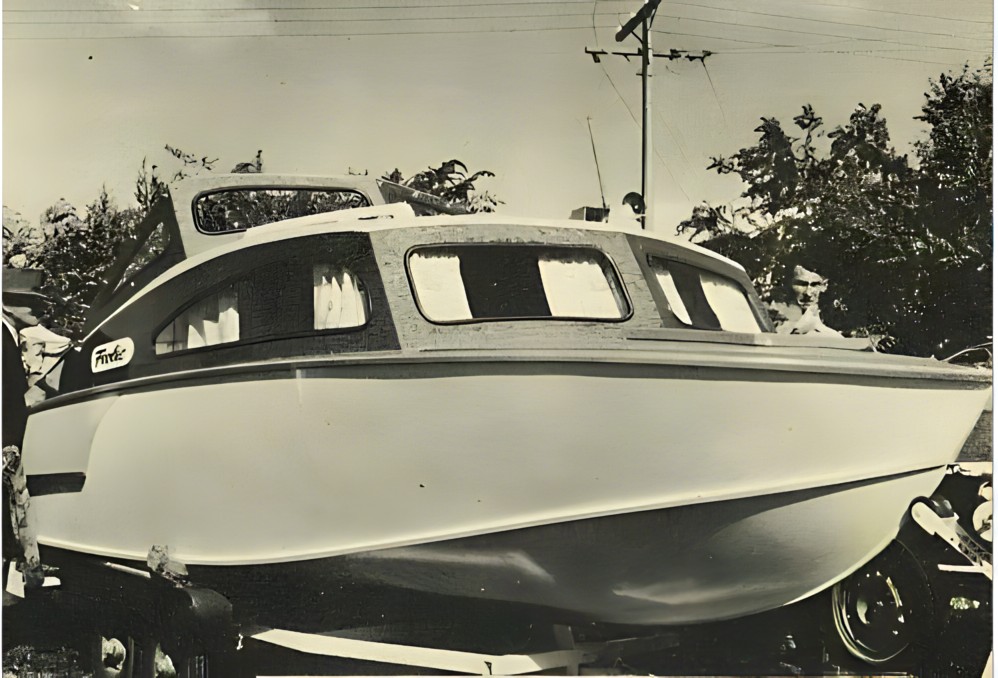
TIMBER STILL KING
Always an innovator, in 1958, Carl Augustin showed off his prototype tunnel drive system
using a conventional propeller and underwater gear. The public never really bought into it, although DIYs built plenty of boats with the tunnel drive concept. It was the prop and drive protection, plus the ability to get into shallow water, that people liked. Leo Young, the king of fast speedboat racing SK hulls, went a step further and developed a tunnel drive system, arguably the most efficient available, and sold them as moulded fibreglass units ready to be installed in wooden or fibreglass hulls. Rex Henry gained prominence for custom built timber runabouts and later became the chief designer for Fleetline Boats, one of the largest fibreglass boat builders for many years. Richard Hartley’s boat plans enjoyed continued popularity amongst amateur builders, as did Carl Augustin’s, but the fibreglass revolution was starting. Plylite Boat Construction of Paraparaumu was New Zealand’s largest producer of plywood craft, with over 30 boats in various stages of production at any one time. They launched a new kitset enterprise for the Australian and New Zealand markets with 1000 sets of plans for two different models and sold them all. Some other new brand names that gained popularity during the 1950s were Fleetcraft, Willetts, Brin Wilson, Sportcraft, Vistacraft and Falcon. Vistacraft went on to be a popular fibreglass brand years later. Another notable brand name of the time was Marksply (Dave Marks), who built 5.2 m, 5.8 m and 6.1 m lapstrake plywood cabin runabouts. Sonata Laboratories introduced the Falcon 15, a 4.6m cabin boat aimed at the easy-to-build kitset market. Hartley’s Guide to Boat Building featured 80 diagrams and 45 photos and became one of the most widely read boatbuilding books ever, not just in New Zealand, but world-wide. The
sale of his boat plans all over the world, for rowing dinghies, powerboats and sailing vessels, made Richard Hartley quite a wealthy man. Down in the Waikato, Rollo Dutton started building plywood trailer boats in 1958 (through to the 1960s). He built 180 boats of varying sizes from 15’ to 25’ inboard and outboard styles, based on Carl Augustin designs. After this, Rollo changed the business to retail, selling some of the early start GRP boats such as Crestacraft, Condorcraft and Fi-Glass.
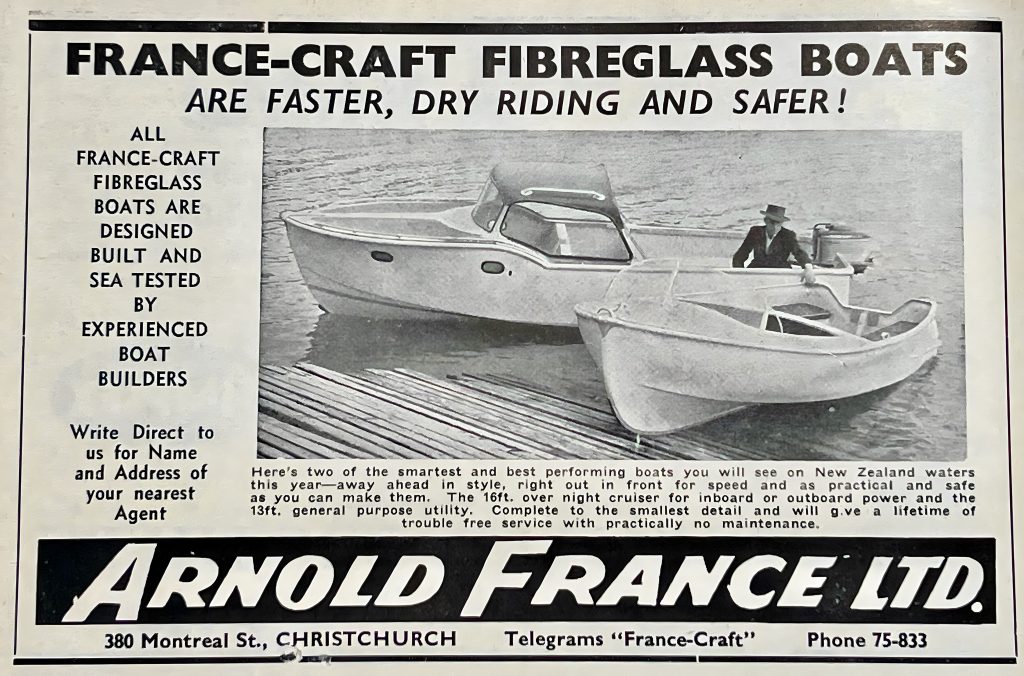
FIBREGLASS GAINS MOMENTUM
We started to see adverts in Sea Spray magazine for galvanised and zinc-sprayed pipe steel trailers advertised by Tapper Transport of Auckland to suit 3.5 m to 6 m boats. The trailers were very crude by today’s standards but certainly did the job they were designed for. I remember my father welding up his own pipe trailer to put under his home-built 6.1m Hartley. The OBC held a boat show in the carpark of the Farmers Trading Co, attended by over 15000 people. Two-thirds of the 47 boats on display were amateur designed and built. There was only one imported boat, and the centrepiece was Jack Stewart’s 6.5m Naiad. Other attractions were an electric trailer winch, an electro-hydraulic motor tilt, an automatic ski reel and the latest Hutchwilco life jackets from J.F. Hargrave Ltd. In 1958, one of New Zealand’s most respected boat builders, Collings & Bell, based in St Mary’s Bay, Auckland, built their last boat, a 5.2m runabout powered by a Hamilton jet. They were forced to close due to the opening of the Auckland Harbour Bridge. 1958 also saw the formation of the National Water Ski Association, and Hamilton Jets conquered the Colorado River and gained worldwide recognition for inventor C.W.F. Hamilton of Christchurch. As the 1950s drew to a close, trailer boats had seen massive growth with more professional builders, but still a strong DIY sector. Outboards had increased to 70hp, although they were hard to get because customers still needed overseas funds to buy them. There was still a big DIY market and along with Carl Augustin, Richard Hartley, Plylite, Jim Young, Len Hodgkinson and others were busy selling plans for the home builder. Sixty boats were on show at the OBC’s second boat show at the Farmers Trading Co. carpark. Smart new paint jobs and racy interiors were now becoming more common. New trailer boat brands appeared – Seaworthy Craft, Marlin, Mastercraft, Victor, Smallboats, Flaircraft, Mitchcraft, South Pacific and Duraglass. All of them have long since gone. New Zealand’s first power catamaran was launched at Kawerau by A. Sayers. Powered by a Ford V8, it was built from four flying boat wing floats with the tails chopped off and joined together. The power cat revolution had started….well almost. While outboards were certainly taking root with the trailer boat fraternity, Arnold France was not letting them take all the market and, in 1959 released his France Craft Senior stern drive. This was a significant breakthrough in trailer boat propulsion.
With the sad recent passing of Barry Thompson (along with the loss of his wealth of power boat knowledge), we will still be looking to continue this series and cover the decade of the 1960s in the Jan/Feb issue.


